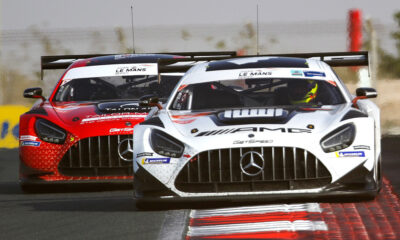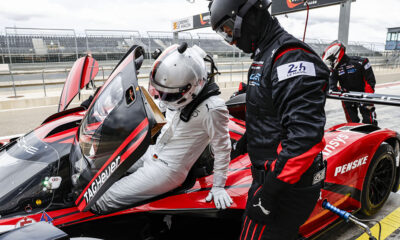
Photo: Ford
GTE-Pro manufacturers have expressed mixed feelings following unprecedented Balance of Performance changes on the eve of the 84th running of the 24 Hours of Le Mans.
The FIA and ACO issued multiple adjustments, including minimum weight increases for both the class pole-sitting Ford GT (+10kg) and Ferrari 488 GTE (+15kg), as well as a slight boost reduction for the Fords.
Fords locked out the front row in class and took four of the top-five position in qualifying.
“We’re disappointed that our strong qualifying performance has resulted in a slight BoP change,” Raj Nair, Ford’s executive vice president, Global Product Development and chief technical officer told Sportscar365.
“But we’re determined to work through that, overcome that and race hard tomorrow.”
Nair said they are still going through the calculations to determine the exact effects of the boost pressure decrease, which is across all power levels, except at the 7100 RPM redline.
The Fords have consistently been quickest in trap speeds all week, although only 2.5 km/h faster than the quickest normally aspirated car, the Aston Martin Vantage GTE, in qualifying.
“The top speed is what they were looking at,” Nair said. “We’ll work through that.
“We still have a strong car and a strong team. In 24 hours, a lot of race strategy will play into it as well. We’ll run it out and we’ll race.”
Test day pace-setters Corvette Racing, as well as Aston Martin, were the chief beneficiaries of the BoP change, which sees both GTE-Pro cars receive a 0.2mm larger air restrictor, and in effect, slightly more power.
The pair of factory Pratt & Miller-run cars qualified 13th and 14th in class and puts the defending race winners nearly back to its pre-Le Mans configuration, after getting a 0.3mm reduction last week due to its performance at the test.
“It certainly bodes well for the race,” Corvette Racing Program Manager Doug Fehan told Sportscar365. “Obviously, it helps move us a little bit closer, closes the deficit.
“I have no doubt about the effort they put forward to make this correction. I don’t question that for a bit.
“They have a very competent technical staff that I know worked all night long to try and come up with something.”
The team’s challenge, however, is now to machine the restrictors to the new size, with less than 24 hours before the start of the race.
“We do not have 29.0mm restrictors,” Fehan said. “That is going to present a formidable challenge to us, to try and meet that [deadline].
“We have 28.8, if we can possibly locate time on a local CT machine, we can probably take the 28.8 restrictor and get it setup for the 29.0.”
While supportive of the change, AMR Managing Director John Gaw admitted the level of questions that’s been present in the buildup to this year’s race.
“I’m an engineer and I don’t understand all the maths behind it; I don’t think anybody does,” Gaw told Sportscar365.
“I think therein lies some of the issue, which is if the people that do it were just transparent in the decision-making process, it would remove a lot of angst and bitterness.
“Whether it’s right or wrong, who knows, history will tell… But every car that’s entered the race needs to have a fair chance of winning from the start, everybody wants that.
“Nobody wants to win by default or because they had one over on their competitor.
“This probably has made that more of a reality than it was before, whether it’s a true reality or not will be found out in history.”
Risi Competizione technical director Rick Mayer, meanwhile, feels the 15kg weight increase for the Ferraris could impact the results, but not as much due to weight also being added to the Fords.
“Fifteen kilos will hurt, but it’s not like you broke your leg, it’s like you broke a finger,” Mayer told Sportscar365.
“It definitely will slow us down, no question. I would have been happier with 10 kilos if they wanted to do something. They put 10 kilos on the Ford, so we’re OK.
“The real question is what will the true pace of the race be because the Ford’s theoretical fastest qualifying lap was a [3:]50.5.”
One of other key factors, Fehan said, is the barometric pressure setting for the turbocharged cars, which is adjusted according to the altitude and forecasted weather at each track.
The FIA confirmed the levels will remain unchanged from qualifying, despite lobbying from some manufacturers.
“The initial boost setting, or atmospheric setting, will be the determining factor on how the power is regulated. Everything runs relative off of that,” Fehan said.
Ford’s Nair said they were lucky with the weather conditions on Wednesday, which played into their, as well as Ferrari’s hand.
“We could get hurt race day if it’s higher than that,” he said. “That was the luck of the draw of the day.”
While BoP changes were made to Ford, Ferrari, Corvette and Aston Martin, the Porsche 911 RSR did not receive any adjustments, to the dissapointment of the German manufacturer.
The three Porsches in the class qualified 8th, 10th and 12th, nearly four seconds off Dirk Mueller’s pole-winning 3:51.185 lap.
Head of Porsche Motorsport, Dr. Frank-Steffen Walliser, who was visibly upset at the lack of a change, was nearly lost for words.
“It’s a decision of the FIA that we fully respect and now we go racing.”
The Porsches are not expected to factor into the race, unless it rains.
James Newbold contributed to this report


























